
REGULAR ARTICLE
The choice of the fuel assembly for VVER-1000 in a closed fuel
cycle based on REMIX-technology
Evgenii Bobrov
*
, Pavel Alekseev, Alexander Chibinyaev, Pavel Teplov, and Anatoliy Dudnikov
NRC “Kurchatov Institute”, Moscow, Russia
Received: 21 May 2015 / Received in final form: 2 September 2016 / Accepted: 22 September 2016
Abstract. This paper shows basic features of different fuel assembly (FA) application for VVER-1000 in a
closed fuel cycle based on REMIX-technology. This investigation shows how the change in the water–fuel ratio in
the VVER FA affects on the fuel characteristics produced by REMIX technology during multiple recycling.
1 Introduction
There are several problems in the Russian nuclear energy
sector: the huge quantity of accumulated spent nuclear fuel
(SNF) and the limited inventory of cheap natural uranium
for fuel fabrication. The solution of these problems leads to
increase economic attractiveness of the nuclear industry.
The main decision is in the implementation of a closed fuel
cycle and recycling of the SNF. There is program which is
based on the development of fast nuclear reactors in
Russian Federation. This technology will have a significant
contribution to the nuclear energy only in the distant
future. The nuclear power plant fleet in Russia today is
mainly based on the VVER reactors. It is important to
perform the smooth transformation of the current nuclear
system with implementation of thermal reactors in a closed
fuel cycle. It will help to decrease the amount of SNF,
reduce natural uranium consumption and improve reproc-
essing technologies.
There is experience of regenerated material imple-
mentation in the thermal reactors in the world based on
the MOX-technology [1]. The main problem of MOX
fuel usage is the degradation of Pu isotopic composition.
The high level of Pu content in the fuel leads to limited
(∼30%) MOX fuel assemblies (FAs) loading in the core.
The regenerated uranium (received in the reprocessing
process) is stored or partly used for regenerated fuel
fabrication. In Russia, the uranium separated from spent
VVER-440 fuel is mixed with the uranium extracted
from the spent BN-600 fuel andthenusedforfabricating
RBMK-1000 fuel [1]. In this case, only regenerated
uranium is used and plutonium is stored. The storage
of regenerated Pu is very expensive.
In papers [2–4], it has been proposed to use in thermal
reactors fuel made from unseparated mixtures of uranium
and plutonium isotopes blended with enriched natural
uranium. Such fuel is called as REMIX-fuel. Fuel
fabrication technology is called REMIX-technology.
During reprocessing minor actinides and fission products
(FPs) are removed. The main achievements of the REMIX-
technology are simplified reprocessing process, natural
uranium savings, multiple recycling and the possibility of
full core loading. In papers [5,6], some new variants of the
REMIX-fuel have been proposed, based on different feeding
and fissile materials like
232
Th,
238
U,
233
U and
239
Pu. It has
beenshownthatpresenceofconstantfeedingthefuelisotopic
composition goes to an equilibrium state.
This paper shows the main features of the different FA
concepts application in the VVER-1000 in a closed fuel
cycle based on the REMIX-technology. FAs with different
water to uranium volume ratios and three concepts of the
REMIX-fuel were considered:
–water–fuel ratio changes in the range of 1.5–2.5 in the
FAs (different FA variants);
–the fuel cycle is based on traditional REMIX-fuel with
highly enriched uranium feeding, regenerated REMIX
(MOX)-fuel with the reactor grade plutonium (RgPu)
feeding or U–Th fuel (new REMIX(Th))with
233
U feeding.
The reactor grade plutonium (RgPu) obtained by
reprocessing of the SNF UO
2
from VVER-1000 with
average burnup 49.3 MW d/kg
HM
and the average enrich-
ment ∼4.1 wt.%.
The basic attention in this paper focuses on the such
results:
–the feeding material consumption (high-enriched urani-
um (HEU), RgPu and
233
U) during multiple recycling;
–the isotopic composition behavior (plutonium composi-
tion) during multiple recycling.
This values influence on the economical and the
technical features of the fuel cycle.
* e-mail: Bobrov_EA@nrcki.ru
EPJ Nuclear Sci. Technol. 2, 42 (2016)
©E. Bobrov et al., published by EDP Sciences, 2016
DOI: 10.1051/epjn/2016035
Nuclear
Sciences
& Technologies
Available online at:
http://www.epj-n.org
This is an Open Access article distributed under the terms of the Creative Commons Attribution License (http://creativecommons.org/licenses/by/4.0),
which permits unrestricted use, distribution, and reproduction in any medium, provided the original work is properly cited.

Water–fuel ratio = 1.5 can be achieved with an
extended fuel rod diameter or by the usage tight lattice
with additional fuel rod's row (like VVER-S FA [7]).
Obviously, the fuel loading increases in comparison with
the standard FA.
Water–uranium ratio = 2.5 can be achieved by increas-
ing inner hole in the fuel pellet or removal of some fuel rods
from FA. In this case, the fuel loading can decrease in
comparison with the standard FA.
It should be noted that any changes in the FA design
can influence to the operational characteristics of the FA in
the VVER core. In this paper, these changes are not
considered.
This parametric investigation has goal to show the
water–fuel ratio impact to the fuel cycle characteristics.
The neutron-physics calculations in this work were
performed by the Consul code package [8]. All calculations
were performed for the VVER-1000 reactor. Fuel campaign
is 4 years with average burnup 49.3 MW d/kg HM.
2 The water–fuel ratio impact on the
REMIX-fuel characteristics with HEU feeding
This section shows how the water–fuel ratio value affects to
the REMIX-fuel characteristics with HEU feeding during
multiple recycling. Such fuel is fabricated on the basis of
the unseparated uranium and plutonium mixture from
SNF reprocessing after irradiation in the VVER-1000 core
and the HEU. The unseparated mixture fraction in the fuel
is ∼95%. All volume of the unseparated mixture from SNF
is used to fabricate the REMIX-fuel. The fuel cycle
flowchart with such fuel is presented in Figure 1.
In order to obtain the unseparated mixture (U + Pu) for
REMIX-fuel fabrication for the first recycling step for all
water–fuel ratio values (FA variants), a calculation of a
standard UO
2
fuel cycle was performed, with an average
enrichment of 4.1 wt.% and average burnup 49.3 MW d/
kg
HM
.
For the next recycling steps (from the second recycle),
the unseparated mixture was taken from the SNF for each
specific FA variant. For example, starting from second
recycle during fuel fabrication for the FA with water–fuel
ratio = 1.5, the reprocessed mixture (UO
2
+ PuO
2
) was
taken from the SNF in the FA with the water–fuel
ratio = 1.5. For others FA variants are similar.
Five sequential recycles were considered. On each cycle
(recycle), the
235
U extra mass (as a part of HEU) fraction as
a supplement to the unseparated mixture was selected to
reach the same burnup 49.3 MW d/kg
HM
as in open cycle
with UO
2
(during the irradiation time). In Tables 1–3,
these values for each FA are presented.
Average REMIX-fuel burnup was equal 49.3 MW d/
kg
HM
. Cooling, reprocessing and fuel fabrication duration
take 5 years. During these processes, the disappearance of
241
Pu due to decay in the
241
Am, and transition of
239
Np in
239
Pu was taken into account. It should be noted, during
the reprocessing process, all the minor actinides and FPs
are removed from the SNF after each cycle. The fresh fuel
does not contain americium.
On the first recycle, the minimum
235
U consumption is
observed when we use the FA with the water–fuel
ratio = 2.5. The HEU enrichment in this case is about
∼60%. The natural uranium consumption decreases 32% (if
235
U enrichment in the depleted uranium is 0.1%)
compared to the open fuel cycle. Further,
235
U consump-
tion increases. This is due to the fact that the ratio between
the fissile isotopes (
235
U,
239
Pu,
241
Pu) and absorbing
isotopes (
236
U,
240
Pu,
242
Pu) in the unseparated mixture
which is required for REMIX-fuel fabrication before the
second recycle less than before the first recycle.
On the first recycle, the maximum
235
U consumption
achieved when we use the FA with water–fuel ratio = 1.5.
In this case, the natural uranium economy is only 3% (if
235
U enrichment in the depleted uranium is 0.1%).
On the first recycle, natural uranium economy is 21.5%
for the standard VVER-1000 FA.
After first recycle, there are no advantages in
235
U
consumption for the slightly tight fuel lattice compared
to the standard VVER-1000 fuel lattice. This is due to
the fact that
240
Pu accumulates (after third recycle,
shown in Tabs. 1–3)moresignificantly (almost 2-fold),
than when using the standard VVER-1000 fuel lattice.
On the five recycle, the natural uranium consumption
reduces on 28% compared to the open fuel cycle
(standard UO
2
fuel cycle with an average enrichment
of 4.1 wt.%) (Fig. 2).
Tables 4–6show information about the plutonium
isotopic composition behavior during multiple recycling for
each FA concepts.
Information about the plutonium fraction in the fresh
REMIX-fuel on each considered cycle is presented in
Figure 3.
How we can see from Tables 4–6, plutonium composi-
tion in the fuel changes little during multiple recycling for
all FA concepts. These are differences in plutonium
concentrations (predominantly
238
Pu,
240
Pu).
For the standard VVER-1000 FA, the plutonium
content into the fresh fuel (or reactor core) after multiple
recycling tends to 2% and stabilized (Fig. 3). There is a
limit on the Pu content in the core. For the FA with
water–fuel ratio equal 1.5, this value tends to 2.5%. This
value is below the limit on 20%. If we use the FA with
extended fuel lattice, the most minimum value (1.5–1.6%)
of the Pu content is observed. This value is two times lower
than the limit.
Fig. 1. Flowchart with REMIX-fuel with HEU feeding.
2 E. Bobrov et al.: EPJ Nuclear Sci. Technol. 2, 42 (2016)

Table 2. REMIX fuel composition for FA with water/fuel ratio = 2.0.
Water/fuel ratio = 2.0 1 Recycle (%) 2 Recycle (%) 3 Recycle (%) 4 Recycle (%) 5 Recycle (%)
Unseparated mixture
235
U 0.72 1.02 1.21 1.32 1.39
236
U 0.56 0.97 1.35 1.69 2.01
238
U 92.44 91.26 90.44 89.84 89.35
238
Pu 0.03 0.06 0.10 0.12 0.14
239
Pu 0.60 0.71 0.76 0.80 0.82
240
Pu 0.28 0.36 0.39 0.40 0.41
241
Pu 0.14 0.19 0.21 0.22 0.23
242
Pu 0.09 0.17 0.22 0.24 0.25
+HEU
235
U extra mass fraction 3.16 3.01 2.93 2.90 2.89
238
U 2.00 2.24 2.40 2.47 2.49
Table 1. REMIX fuel composition for FA with water/fuel ratio = 1.5.
Water/fuel ratio = 1.5 1 Recycle (%) 2 Recycle (%) 3 Recycle (%) 4 Recycle (%) 5 Recycle (%)
Unseparated mixture
235
U 0.72 1.72 2.02 2.23 2.40
236
U 0.56 1.05 1.46 1.83 2.18
238
U 92.44 90.09 88.90 88.00 87.26
238
Pu 0.03 0.08 0.13 0.17 0.21
239
Pu 0.60 0.99 1.15 1.24 1.31
240
Pu 0.28 0.40 0.49 0.54 0.58
241
Pu 0.14 0.23 0.28 0.31 0.34
242
Pu 0.09 0.14 0.18 0.20 0.22
+HEU
235
U extra mass fraction 4.13 3.24 3.10 3.06 3.03
238
U 1.03 2.07 2.29 2.40 2.47
Table 3. REMIX fuel composition for FA with water/fuel ratio = 2.5.
Water/fuel ratio = 2.5 1 Recycle (%) 2 Recycle (%) 3 Recycle (%) 4 Recycle (%) 5 Recycle (%)
Unseparated mixture
235
U 0.72 0.87 1.02 1.13 1.18
236
U 0.56 0.97 1.36 1.73 2.07
238
U 92.44 91.70 90.97 90.38 89.90
238
Pu 0.03 0.05 0.07 0.09 0.10
239
Pu 0.60 0.56 0.58 0.60 0.62
240
Pu 0.28 0.34 0.35 0.35 0.36
241
Pu 0.14 0.16 0.17 0.17 0.18
242
Pu 0.09 0.19 0.23 0.26 0.27
+HEU
235
U extra mass fraction 3.08 3.17 3.16 3.10 3.07
238
U 2.08 2.00 2.08 2.18 2.24
E. Bobrov et al.: EPJ Nuclear Sci. Technol. 2, 42 (2016) 3

Therefore, 100% REMIX-fuel loading in the VVER-
1000 core does not reduce the reactor safety performance
during multiple recycling [5].
It should be recalled that,
238
Pu introduce a
significant contribution in the residual heat. It is
therefore important to monitor this value in the process
of recycling. The most maximum value of the
238
Pu
accumulation is observed for the FA with water–fuel
ratio equal 1.5. In the future, it will require an estimate
of the radiation characteristics and residual heat for fresh
and burnt fuel.
Thus, we can conclude that, more ideal
235
U consump-
tion achieved in the FA with a water fuel ratio equal 2.00
(standard VVER-1000 FA) for the base variant of the
REMIX-fuel. There is no need to change anything in the
core design.
Table 5. Plutonium isotopic composition for FA with water/fuel ratio = 2.0.
Water/fuel ratio = 2.0 1 Recycle (%) 2 Recycle (%) 3 Recycle (%) 4 Recycle (%) 5 Recycle (%)
238
Pu 2.53 4.37 5.70 6.72 7.53
239
Pu 53.00 47.57 45.60 44.59 44.01
240
Pu 24.73 23.89 23.15 22.68 22.35
241
Pu 12.09 12.73 12.69 12.60 12.52
242
Pu 7.65 11.44 12.86 13.42 13.60
Table 6. Plutonium isotopic composition for FA with water/fuel ratio = 2.5.
Water/fuel ratio = 2.5 1 Recycle (%) 2 Recycle (%) 3 Recycle (%) 4 Recycle (%) 5 Recycle (%)
238
Pu 2.53 4.01 5.15 6.06 6.80
239
Pu 53.00 43.33 41.62 40.83 40.29
240
Pu 24.73 26.08 24.66 23.90 23.49
241
Pu 12.09 12.21 11.86 11.69 11.59
242
Pu 7.65 14.38 16.70 17.51 17.83
Table 4. Plutonium isotopic composition for FA with water/fuel ratio = 1.5.
Water/fuel ratio = 1.5 1 Recycle (%) 2 Recycle (%) 3 Recycle (%) 4 Recycle (%) 5 Recycle (%)
238
Pu 2.53 4.43 5.84 6.92 7.80
239
Pu 53.00 53.81 51.64 50.35 49.57
240
Pu 24.73 21.73 21.86 21.85 21.77
241
Pu 12.09 12.44 12.70 12.73 12.67
242
Pu 7.65 7.59 7.96 8.15 8.18
0%
5%
10%
15%
20%
25%
30%
35%
1 recycle 2 recycle 3 recycle 4 recycle 5 recycle
Water/Fuel=1.5 Water/Fuel=2.0 Water/Fuel=2.5
Fig. 2. Natural uranium consumption reduction for each FA
concepts during multiple recycle.
0.0%
0.5%
1.0%
1.5%
2.0%
2.5%
3.0%
1 recycle 2 recycle 3 recycle 4 recycle 5 recycle
Water/Fuel ratio=1.5 Water/Fuel ratio=2.0
Water/Fuel ratio=2.5
Fig. 3. The plutonium fraction in the fresh REMIX-fuel (for each
FA concepts).
4 E. Bobrov et al.: EPJ Nuclear Sci. Technol. 2, 42 (2016)

3 The water–fuel ratio impact on the REMIX
(MOX)-fuel characteristics with reactor
grade Pu feeding
This section shows the water–fuel ratio value influence on
the REMIX(MOX)-fuel characteristics with RgPu feeding
during multiple recycling.
REMIX(MOX)-fuel is produced on a basis of the
unseparated uranium–plutonium mixture from spent
MOX-fuel on the first recycle (from the spent REMIX
(MOX)-fuel starting from two recycle) and RgPu from
SNF UO
2
fuel for VVER-1000.
To obtain the spent MOX-fuel for the REMIX-fuel
fabrication for the first recycling step for all FA concepts,
the fuel loading with MOX-fuel was calculated. This
calculation was made for the FA with water–fuel ratio
equal 2.0 (standard for VVER-1000 FAs). An average
RgPu mass fraction in the MOX-fuel is 9.5%. Average
burnup is 49.3 MW d/kg
HM
.
For the next recycling steps (after first recycle) the
unseparated mixture (U + Pu) is taken from the spent
REMIX(MOX)-fuel for each specific FA concepts.
Five recycles with this fuel were calculated.
On each recycle, RgPu mass fraction was chosen so that
burnup was equal to the core with the standard VVER-
1000 UO
2
fuel (49.3 MW d/kg
HM
). For each FA concepts
this condition is satisfied.
The fuel cycle flowchart is presented in Figure 4.In
Figure 5 , information about RgPu consumption on the
each recycle is presented.
The RgPu consumption decreases during multiple
recycle for all considered FAs. This is due to the use of
the SNF after each recycle.
On the first recycle, a maximal Pu consumption is
observed, when we use the FA with the water–fuel ratio
equal 1.5. This is due to the fact that we have a hard
neutron spectrum in the region with the water–fuel ratio
equal 1.5 due to the reduction of the water nuclei
number. However, this allow to increase the plutonium
content in the spent REMIX(MOX) fuel after first
recycle (according to Fig. 6). The breeding ratio for the
water–fuel ratio 1.5 is higher than for to the water fuel
ratios 2.0 and 2.5. Further, plutonium consumption
decreases compared to the water–fuel ratios 2.0 and 2.5.
On the five recycle, we show the minimum RgPu
consumption for the FA with the water–fuel ratio equal
1.5. In this case, according to Figure 7,thenatural
uranium consumption reduces on 24% compared to the
open fuel cycle (standard UO
2
fuel cycle with an average
enrichment of 4.1 wt.%).
It should be noted that, this fuel is not loaded in the
100% VVER-1000 core, because the FA have high Pu
content (according to Fig. 8). There is a limit on the Pu
content in the core.
0%
2%
4%
6%
8%
10%
Water/Fuel=1,5 Water/Fuel=2,0 Water/Fuel=2,5
Fig. 5. RgPu consumption on the each recycle during the
multiple recycling of the REMIX(MOX)-fuel for each FA
concepts.
Fig. 4. The flowchart with REMIX(MOX)-fuel.
0.0%
5.0%
10.0%
15.0%
before
MOX
before 1
recycle
before 2
recycle
before 3
recycle
before 4
recycle
Water/Fuel=1,5 Water/Fuel=2,0 Water/Fuel=2,5
Fig. 6. The plutonium fraction in the unseparated mixture of the
U and Pu isotopes, which is required for REMIX(MOX)-fuel
fabrication (for each FA concepts).
0%
5%
10%
15%
20%
25%
30%
1 recycle 2 recycle 3 recycle 4 recycle 5 recycle
Water/Fuel=1.5 Water/Fuel=2.0 Water/Fuel=2.5
Fig. 7. Natural uranium consumption reduction for each FA
concepts during multiple recycle.
E. Bobrov et al.: EPJ Nuclear Sci. Technol. 2, 42 (2016) 5







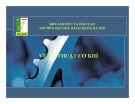
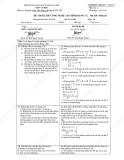
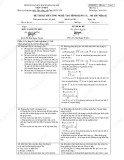
![Đề thi Công nghệ tạo hình dụng cụ năm 2020-2021 - Đại học Bách Khoa Hà Nội (Đề 4) [Kèm đáp án]](https://cdn.tailieu.vn/images/document/thumbnail/2023/20230130/phuong62310/135x160/3451675040869.jpg)





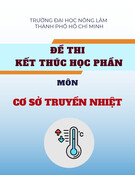
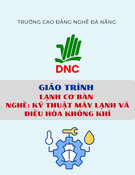
![Ngân hàng trắc nghiệm Kỹ thuật lạnh ứng dụng: Đề cương [chuẩn nhất]](https://cdn.tailieu.vn/images/document/thumbnail/2025/20251007/kimphuong1001/135x160/25391759827353.jpg)







